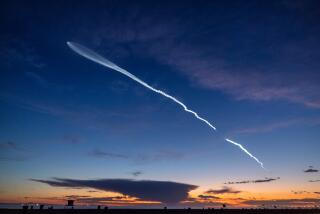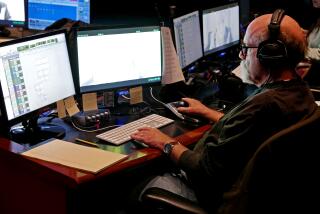Breaking Sound of Speed
- Share via
EDWARDS AIR FORCE BASE — Above the barren desert where Chuck Yeager cracked the sound barrier and rattled the aviation world nearly six decades ago, researchers are testing the aerospace version of a Midas muffler for supersonic jets.
Their goal: to quiet the cannon-like booms emitted by aircraft flying faster than the speed of sound, whose shock waves are strong enough to shatter windows.
This week, an F-5E fighter whose shape had been modified by Northrop Grumman Corp. engineers began a series of test flights. Initial results showed that the new technology cut the noise level of sonic booms in half.
Rather than change the engine or place a muffler on the jet nozzle, the Northrop engineers installed a “nose glove” made of a graphite epoxy and aluminum skin over the nose and the bottom of the fuselage. The design change makes the once-slick-looking jet resemble a skinny pelican. But the new shape apparently reduces the shock waves during a supersonic flight.
The research eventually could lead to supersonic commercial flights over land, currently banned because of the loud sonic booms they generate. The now-removed-from-service Concorde, for instance, was allowed to fly at supersonic speeds only while over the ocean. That limited the plane to landing at two East Coast airports, a restriction that doomed it from becoming a commercial success.
“We’re going to fix the sound barrier that Chuck Yeager broke,” said Northrop test pilot Roy Martin.
The project is generating significant interest from the Pentagon and manufacturers of business jets.
Military jets can fly supersonic -- faster than 750 mph -- only while above military ranges and over the ocean. Finding a way to muffle sonic booms also could help military fighters fly faster to targets without being detected.
The supersonic SR-71 Blackbird spy plane flew high enough and fast enough to avoid antiaircraft missiles. But the SR-71’s presence was easily detected because of the loud sonic boom that could be heard 40 miles away. In addition, the current generation of stealth planes such as the B-2 bomber and F-117 fighter fly at subsonic speeds to avoid detection.
A quiet supersonic jet also appeals to manufacturers of business jets.
Gulfstream Aerospace Corp. is one of several makers of private planes that have formed their own research teams to develop technology to muffle sonic booms, which could spur demand for small supersonic planes from business executives pressed for time. A supersonic business jet could slash flight times from New York to Los Angeles by a third or more, they said.
“It’s possible to build a supersonic business jet today, but that’s not the issue,” said Robert Baugniet, spokesman for Gulfstream, a subsidiary of General Dynamics Corp. “The issue is can you suppress sonic booms so you can travel transcontinental, let’s say from New York to Los Angeles, without raising environmental concerns.”
The Northrop Grumman flights, continuing over the next week, are part of a race among aerospace companies to develop the first quiet supersonic aircraft.
At Lockheed Martin Corp.’s famed Skunk Works in Palmdale, about 50 engineers are working to develop a supersonic business jet with muffled sound. The project began in 2001, and the experimental plane has undergone wind-tunnel test and computer studies. Boeing Co. and Raytheon Corp. also are involved in projects to quiet sonic booms.
A sonic boom is caused by a sudden change in air pressure. Much as when waves are created when a ship’s bow cuts through water, an aircraft flying at supersonic speed creates a shock wave of air, one that creates loud cracks that can be heard on the ground below.
The Concorde flying at supersonic speed, for instance, produced a shock wave on the ground of about 2 pounds of pressure per square foot.
Researchers have found they can suppress supersonic pressure on smaller aircraft to about 0.8 pound or 0.9 pound per square foot, with the ultimate goal of 0.3 pound.
If the new shape works, the sonic boom will sound “more like a distant thunder or a dull thud, something that might be acceptable to people on the ground, “ said Ed Haering, principal investigator of NASA’s Shaped Sonic Boom Experiment program, which is funding the test flights.
Working with NASA, Northrop began testing the muzzled jet this week. Pilots flew both the modified F-5E and an unmodified F-5E over the same course where Yeager first broke the sound barrier in 1947.
Flying at 32,000 feet, the muffled jet hit a speed of 1,050 mph, or 1.4 times the speed of sound. On the ground below, microphones and sensors placed across a 2-mile path monitored the sonic booms. Forty-five seconds later, the unmodified F-5E flew the same route.
Both planes produced sonic booms, although to the human ear the boom of the unmuffled aircraft seemed slightly louder. Later, researchers looking at sound data found that the intensity of the shock wave from the modified airplane was nearly 50% less than that from the unmodified F-5E. Data showed that the pressure produced by the muffled plane had been reduced to about 0.6 pound of pressure per square foot.
“We’ve got a long way to go, but I feel this is a significant achievement,” said David Graham, an aerodynamics engineer for Northrop Grumman.
More to Read
Inside the business of entertainment
The Wide Shot brings you news, analysis and insights on everything from streaming wars to production — and what it all means for the future.
You may occasionally receive promotional content from the Los Angeles Times.










